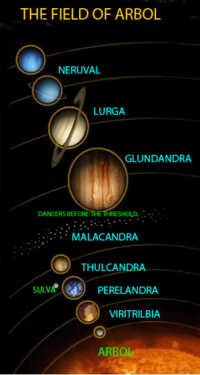
Clive Staples Lewis was a British writer, literary scholar, and Anglican lay theologian. He held academic positions in English literature at both Magdalen College, Oxford (1925–1954), and Magdalene College, Cambridge (1954–1963). He is best known as the author of The Chronicles of Narnia, but he is also noted for his other works of fiction, such as The Screwtape Letters and The Space Trilogy, and for his non-fiction Christian apologetics, including Mere Christianity, Miracles, and The Problem of Pain.

Mars, the fourth planet from the Sun, has appeared as a setting in works of fiction since at least the mid-1600s. Trends in the planet's portrayal have largely been influenced by advances in planetary science. It became the most popular celestial object in fiction in the late 1800s, when it became clear that there was no life on the Moon. The predominant genre depicting Mars at the time was utopian fiction. Around the same time, the mistaken belief that there are canals on Mars emerged and made its way into fiction, popularized by Percival Lowell's speculations of an ancient civilization having constructed them. The War of the Worlds, H. G. Wells's novel about an alien invasion of Earth by sinister Martians, was published in 1897 and went on to have a major influence on the science fiction genre.
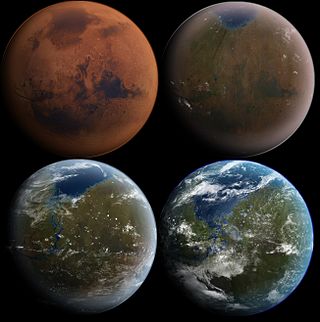
Terraforming or terraformation ("Earth-shaping") is the hypothetical process of deliberately modifying the atmosphere, temperature, surface topography or ecology of a planet, moon, or other body to be similar to the environment of Earth to make it habitable for humans to live on.

That Hideous Strength: A Modern Fairy-Tale for Grown-Ups is a 1945 novel by C. S. Lewis, the final book in Lewis's theological science fiction Space Trilogy. The events of this novel follow those of Out of the Silent Planet and Perelandra and once again feature the philologist Elwin Ransom. Yet unlike the principal events of those two novels, the story takes place on Earth rather than elsewhere in the Solar System. The story involves an ostensibly scientific institute, the N.I.C.E., which is a front for sinister supernatural forces.
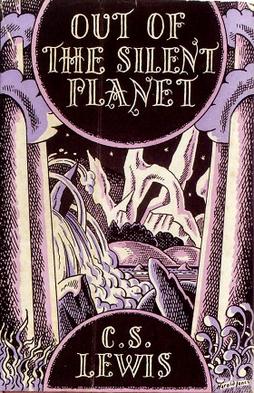
Out of the Silent Planet is a science fiction novel by the British author C. S. Lewis, first published in 1938 by John Lane, The Bodley Head. Two sequels were published in 1943 and 1945, completing the Space Trilogy.
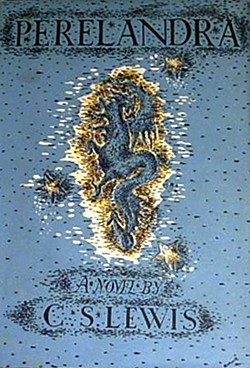
Perelandra is the second book in the Space Trilogy of C. S. Lewis, set on the planet of Perelandra, or Venus. It was first published in 1943.

The Dark Tower is an incomplete manuscript written by C. S. Lewis that appears to be an unfinished sequel to the science fiction novel Out of the Silent Planet, though allegations have been raised about its authenticity. Perelandra instead became the second book of Lewis' Space Trilogy, concluded by That Hideous Strength. Walter Hooper, Lewis' literary executor, titled the fragment and published it in the 1977 collection The Dark Tower and Other Stories. The Lewis scholar Kathryn Lindskoog challenged the authenticity of the work.

In Philip Pullman's His Dark Materials and The Book of Dust trilogies, Dust or Rusakov particles are particles associated with consciousness that are integral to the plot. In the multiverse in which these trilogies are set, Dust is attracted to consciousness, especially after puberty; the Church within the series associates Dust with original sin and seeks its end. Pullman described Dust in an interview as "an analogy of consciousness, and consciousness is this extraordinary property we have as human beings".
Professor Weston is a Satanic character in C. S. Lewis's The Space Trilogy. He is introduced in the trilogy's first book, Out of the Silent Planet (1938), as an eminent physicist who has invented space travel. He is defeated by the novel's protagonist Elwin Ransom on Mars. Weston returns in the second book, in an attempt to wreak havoc on Venus (Perelandra), the "new Eden."

The planet Venus has been used as a setting in fiction since before the 19th century. Its opaque cloud cover gave science fiction writers free rein to speculate on conditions at its surface—a "cosmic Rorschach test", in the words of science fiction author Stephen L. Gillett. The planet was often depicted as warmer than Earth but still habitable by humans. Depictions of Venus as a lush, verdant paradise, an oceanic planet, or fetid swampland, often inhabited by dinosaur-like beasts or other monsters, became common in early pulp science fiction, particularly between the 1930s and 1950s. Some other stories portrayed it as a desert, or invented more exotic settings. The absence of a common vision resulted in Venus not developing a coherent fictional mythology, in contrast to the image of Mars in fiction.
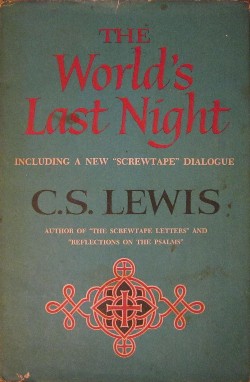
The World's Last Night and Other Essays is a collection of essays by C. S. Lewis published in the United States in 1960. The title essay is about the Second Coming of Jesus Christ. The volume also contains a follow-up to Lewis' 1942 novel The Screwtape Letters in the form of "Screwtape Proposes a Toast." The second, fourth and fifth pieces were published in the U.K. in a volume called Screwtape Proposes a Toast and other pieces (1965); the first, sixth and seventh were published in the U.K. in Fern-seed and Elephants and other essays on Christianity (1975). All the pieces were later collected in the comprehensive Essay Collection and Other Short Pieces (2000).
Elwin Ransom is the main character in the first two books of C.S. Lewis' The Space Trilogy, namely Out of the Silent Planet and Perelandra. In the final book, That Hideous Strength, he is a lesser character in charge of a group that is resisting demons that are trying to take over Earth, and playing the role of a mentor.

The First Men in the Moon is a scientific romance, originally serialised in The Strand Magazine and The Cosmopolitan from November 1900 to June 1901 and published in hardcover in 1901, by the English author H. G. Wells, who called it one of his "fantastic stories". The novel tells the story of a journey to the Moon undertaken by the two protagonists: a businessman narrator, Mr. Bedford; and an eccentric scientist, Mr. Cavor. Bedford and Cavor discover that the Moon is inhabited by a sophisticated extraterrestrial civilisation of insect-like creatures they call "Selenites". The inspiration seems to come from the famous 1865 book by Jules Verne, From the Earth to the Moon, and the opera by Jacques Offenbach from 1875. Verne's novel also uses the word "Selenites" to describe inhabitants of the Moon.

Farewell, Fantastic Venus is a 1968 American science fiction anthology edited by Brian Aldiss and Harry Harrison. An abridged version was published in the same year under the title All About Venus. It was first published as a direct response to the information returned from the first space probes sent to Venus, especially the first atmospheric probe to return data, Venera 4. The first data was not returned from the surface until Venera 7 successfully landed in 1970.
The Grand Tour is a series of novels written by American science fiction author Ben Bova.
This is a list of writings by C. S. Lewis.

In astrology, planets have a meaning different from the astronomical understanding of what a planet is. Before the age of telescopes, the night sky was thought to consist of two similar components: fixed stars, which remained motionless in relation to each other, and moving objects/"wandering stars", which moved relative to the fixed stars over the course of the year(s).

The Monster Who Ate Jesus is the first studio album of Indianapolis Christian horror punk band Blaster the Rocket Man under Jackson Rubio Records, released August 10, 1999. Though technically the band's first album, the group has put out two previous records under a different name, Blaster the Rocketboy, and with a different label, Boot to Head Records.
